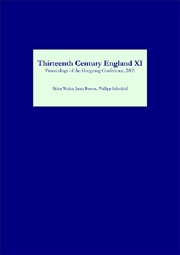Book contents
- Frontmatter
- Contents
- LIST OF ILLUSTRATIONS
- PREFACE
- CONTRIBUTORS
- ABBREVIATIONS
- ‘Adam of Bristol’ and Tales of Ritual Crucifixion in Medieval England
- Ethics and Office in England in the Thirteenth Century
- Some Aspects of the Royal Itinerary in the Twelfth Century
- The minority governments of Henry III, Henry (VII) and Louis IX compared
- Scottish Queenship in the Thirteenth Century
- Ethnicity, personal names, and the nature of Scottish Europeanization
- Power, Preaching and the Crusades in Pura Wallia c.1180–c.1280
- A Forgotten War: England and Navarre, 1243·4
- The Appointment of Cardinal-deacon Otto as Legate in Britain (1237)
- Matthew Paris and John Mansel
- The Burial of Noblewomen in Thirteenth-Century Shropshire
- Dynastic Conflict in thirteenth-century Laxton
- Absenteeism: The Chronology of a Concept
Some Aspects of the Royal Itinerary in the Twelfth Century
Published online by Cambridge University Press: 12 September 2012
- Frontmatter
- Contents
- LIST OF ILLUSTRATIONS
- PREFACE
- CONTRIBUTORS
- ABBREVIATIONS
- ‘Adam of Bristol’ and Tales of Ritual Crucifixion in Medieval England
- Ethics and Office in England in the Thirteenth Century
- Some Aspects of the Royal Itinerary in the Twelfth Century
- The minority governments of Henry III, Henry (VII) and Louis IX compared
- Scottish Queenship in the Thirteenth Century
- Ethnicity, personal names, and the nature of Scottish Europeanization
- Power, Preaching and the Crusades in Pura Wallia c.1180–c.1280
- A Forgotten War: England and Navarre, 1243·4
- The Appointment of Cardinal-deacon Otto as Legate in Britain (1237)
- Matthew Paris and John Mansel
- The Burial of Noblewomen in Thirteenth-Century Shropshire
- Dynastic Conflict in thirteenth-century Laxton
- Absenteeism: The Chronology of a Concept
Summary
Any interpretation of the royal itinerary in the twelfth century has to begin with J.E.A. Jolliffe's chapter on the ‘King's Eyre’ in his Angevin Kingship. In that chapter, Jolliffe expressed his view of Angevin kingship in its daily acts of government as being characterised by ‘over-mastering strength … used equably with self-confidence’. It was ‘strength we take for granted’, he stated, as the Angevin kings ‘bludgeoned’ their financial servants – the sheriffs – into ‘honesty and solvency’. And this strength was in part made real by a ‘laborious co-ordination of court and country’ achieved through the process of the king and the court itinerating around the countryside. In Jolliffe's construct, the royal itinerary was a rational business entered into by a king determined to maintain ‘familiarity’ with those whom he had placed in administrative posts around his realm and to maintain relationships with the county communities of the land. ‘Never’ in the stirring words of Jolliffe, ‘was the Crown more constantly present to the nation, more acutely alive to every wind of politics, than in the sixty years between the accession of Henry II and the death of John.’ The royal itinerary of the Angevin kings was, moreover, a ‘steady’ progress – at twenty miles a day – as the king and his court travelled ‘by planned stages’ along the ‘administrative arteries’ of the realm.
- Type
- Chapter
- Information
- Thirteenth Century England XIProceedings of the Gregynog Conference, 2005, pp. 31 - 45Publisher: Boydell & BrewerPrint publication year: 2007



